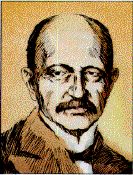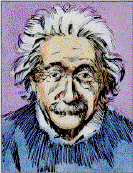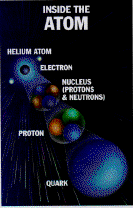Science: Groping in the Light
 |
| Max Planck |
Chapter Three
Perhaps we should not blame Max Planck’s teacher for telling him physics was a dead-end street. It did seem, at the end of the 19th century, that all the major theories were established and the classical physicist’s work was done.
There were still many problems, but it was felt that at least science was now on the right track. The universe seemed like a great machine, still largely unknown, but thanks to Isaac Newton, at least explainable. Whatever was out there could be relied on to work predictably and coherently, obedient to the laws of gravity and motion that ruled the behavior of all moving objects.
But scientists began to notice that Newton’s laws did not give an adequate explanation of all observable phenomena. There were still some awkward paradoxes.
At the turn of the century, Max Planck focused his attention on one of these paradoxes — why heated objects radiated light of different colors as they became hotter. Most of us don’t give this a second thought, but physicists realized this seemed to contradict a basic law of physics.
In 1900, Max Planck advanced a revolutionary explanation: Energy was not radiated in a steady continuous stream, but in precise, discrete units or “packages,” which he called “quanta.” His idea helped explain the enigma of radiated light — but it also opened a door to a whole new way of looking at the universe.
Although quantum theory is now a century old, most people are still unfamiliar with it. Even fewer understand it. However, the expression “quantum leap” has entered our language to describe a sudden change in levels of activity or understanding.
For example, we could say that we hope these articles will be a quantum leap in understanding for you. We’ll soon be looking at some very peculiar ideas. If it gets a bit bewildering, don’t worry. You’re in good company. One of the pioneers of quantum mechanics, physicist Niels Bohr, said, “Anyone who is not shocked by quantum theory has not understood it.”
Understandable or not, quantum theory opened the door to the equally bewildering theory of relativity.
Einstein’s Light Fantastic
 |
| Albert Einstein |
About the time that Planck was advancing quantum theory, a shy young man named Albert Einstein was employed as an examiner at the Swiss patent office in Bern. His job as a patent examiner allowed him much free time, which he spent in scientific investigation.
In 1905, Einstein published a paper on the nature of light. Until the 19th century, light had been thought of as a wave that traveled through “ether,” a mysterious substance that flooded the universe, like the water of a cosmic ocean. But experiments in the 19th century had failed to detect this ether. So, reasoned Einstein, if there was no ether, light could not be a wave, because there was nothing for it to “wave” through.
Given what Max Planck had suggested — that light traveled through space in little packets — Einstein thought light must be made of particles, which were later called “photons.” He discovered, however, that in some instances, light also behaved like a wave. Light was both a wave and a particle — a “wavicle.” Between them, Max Planck and Albert Einstein had opened a window on the extraordinary world of relativity and quantum mechanics.
In 1905, Einstein also published a paper describing his special theory of relativity, which gave a theoretical understanding of a whole host of strange effects in nature that occurred near the speed of light. Newton’s laws had shown that factors governing the speed, direction and mass of an object were constant and thus predictable. For example, if you knew an object’s present location, its speed and direction, you could know for certain exactly where it would be at any given time in the future.
Einstein’s special theory of relativity suggested that the very factors Newton had shown to be constant, were in fact relative. At very high speeds, mass would increase, time slow down and objects actually shorten in the direction of motion.
The only fundamental constant with respect to an observer was the speed of light, always approximately 186,000 miles (300,000 kilometers) a second.
 |
| Bent Space and the Big Bang |
| According to Einstein’s general theory of relativity, matter warps — or curves — “space-time,” causing what we experience as gravity. Diagram at right shows planet following a curved path in space-time caused by a depression made by a star’s great mass. |
Einstein’s general theory of relativity, published in 1915, proposed an even stranger idea. The characteristics of space and time were influenced by the presence of matter. Einstein suggested that the universe was in fact four-dimensional, with time being the fourth dimension. He visualized a universe as an expanse of four-dimensional “space-time,” a concept that even some physicists still find difficult to grasp.
According to Einstein, matter caused depressions in space-time (think of a bowling ball resting on a mattress). The heavenly bodies followed the shortest distance along the curves of these depressions. The earth’s orbit, for example, followed a curved path in space (or rather space-time) caused by a depression made by the great mass of the sun.
You may find this difficult to comprehend. It gets even stranger, as we’ll see.
Bent Space and the Big Bang
Einstein explained that gravity should not be thought of so much as a force that acts on solid bodies, but as the very “fabric” of space-time. It could warp space, slow down time and even bend light.
| “It is difficult to imagine that a handful of residents of a small planet circling an insignificant star in a small galaxy have as their aim a complete understanding of the entire universe, a small speck of creation truly believing it is capable of comprehending the whole” — Murray Gell-Mann |
This was very different from the rather neighborly, predictable cosmos of Isaac Newton. For those who understood the implications of Einstein’s theories, the universe once more became a rather unsettling place.
The complex mathematics of the theories of relativity indicated that the universe was expanding. In 1916, there was no evidence to support this, and Einstein, in what he later said was the biggest mistake of his life, altered the equations to fit the accepted idea of a static universe.
Almost at the same time, the astronomer Vesto Slipher concluded from his observations that about a dozen galaxies were moving away from the earth at speeds up to about 2 million miles (3.2 million kilometers) an hour. In 1929, further observations by the astronomer Edwin Hubble verified Slipher’s conclusions. Far from being a constant size, the universe was expanding by many millions of miles every day. Einstein’s extraordinary ideas seemed plausible.
This raised an obvious question. If the universe was expanding, there must have been a time when everything in it was much closer together. This led modern physicists to a theory of the origin of the universe popularly known as the “big bang.” It proposed that there was a time when everything in the universe was compressed into a single, infinitely dense point. Scientists estimate that sometime between 10 to 20 billion years ago, this incredibly dense mass “exploded” and began expanding at a tremendous rate.
Although this theory is still controversial, many scientists believe it offers an explanation of the origin of the universe. According to the big bang theory, all that we know and see — all matter, all space, even time itself — was created at that moment. The characteristics that decided the nature of the universe were established. Obviously, no one (no one human, at least) was around to know what was happening at the time, but radio telescopes have detected background radiation “noise” that comes from all directions in the sky and is unrelated to any earthbound or individual celestial source. Scientists think it may be a faint echo of the big bang. See companion article on the big bang theory.
One of the more challenging adventures physicists have undertaken in recent years has been to theorize what the universe was like in the first dynamic moments after the so-called big bang.
Matter would not have existed as it does now. Even individual atoms would not have yet formed. The four fundamental forces that scientists believe govern the behavior of matter — gravity, the electromagnetic force, a strong nuclear force that binds the nucleus of the atom, and a weak nuclear force that controls radioactive decay in nature — theoretically existed only as one “superforce.”
Scientists today are hoping to be able to recombine these forces into a grand unified theory. A single theory has been developed for the electromagnetic, strong and weak nuclear forces, but gravity remains the odd one out. So far, scientists have been unable to fit it into a unified theory.
| “What the Universe was like at day minus one, before the big bang, one has no idea. The equations refuse to tell us. I refuse to speculate” — James Peebles |
Nevertheless, it is one of the outstanding achievements of scientists today to have pushed back the frontiers of understanding and built a picture of what the universe was like 10-43 second after an event that scientists believe was creation. To give an idea of how short that is, a thousandth of a second, the limit of accuracy of most stop watches, is expressed as 10-3.
Physicists are still probing, but it seems that at about 10-43 second, calculations and formulas break down. Some doubt that it will ever be known what happened before this time because of the limits of humanity’s ability to theorize via experimentation. But to push past that barrier is one of the great challenges of physics today.
The Wonderful World of Quarks
Relativity is by no means the strangest idea to come from the new understanding of physics. Even more peculiar are the theories that offer a new way of thinking about what things are made of.
We have come a long way from Aristotle’s assumption that the world is made up of earth, fire, water and air. By the 19th century, scientists had learned that the everyday world was made up of combinations of 92 basic elements. Then they discovered that the elements were made up of atoms.
 |
| Until about a hundred years ago, the atom was thought to be the smallest unit of matter. Since then, scientists have discovered that atoms consist of a number of tinier, subatomic particles, As shown in the above diagram of the helium atom (a nucleus with two electrons), protons and neutrons are clustered within the atom’s central region, or nucleus. Swirling around the nucleus is a third kind of subatomic particle, the electron. Each proton and neutron in the nucleus is made up of three tinier particles called quarks, which scientists now believe to be the smallest units of matter. Are quarks the ultimate building blocks of matter? Only time will tell! |
At the beginning of this century, the internal structure of the atom began to be understood. There was a nucleus, surrounded by electrons. Originally, electrons were thought to orbit the nucleus rather like planets in a miniature solar system. That view has been modified. The electron is now understood to be more of an energy-field cloud fluctuating around a solid nucleus, or rather, a not-so-solid nucleus.
The nucleus itself seemed to be composed of two smaller constituents — protons and neutrons. But were protons and neutrons the end of the trail? Or were there still finer levels of smallness?
In 1964, physicists Murray Gell-Mann and George Zweig showed evidence, later confirmed by experiments involving particle accelerators, that protons and neutrons were indeed made up of even more elementary particles, which Gell-Mann called “quarks.”
If Einstein’s view of the universe seemed strange, it was even stranger to look into the miniature world of quarks. Again, “look” is not the right word. You can’t see quarks, and not just because they are too small. They also do not seem to be quite “all there.” They may prove to be the fundamental building blocks of all matter, and yet they do not appear to have an independent existence. An analogy — although an imperfect one, for there are no adequate words to describe this strange world — is a stitch in a knitted sweater. The sweater is made up of stitches, but you can’t have a single stitch by itself. It depends on its relationship with others for its existence.
| “It seems for all purposes that with the discovery of quarks we have reached the end of our journey. But there is an uneasy feeling among physicists that the trip is not over” — Heinz Pagels |
Quarks are grouped to form the protons and neutrons in the atomic nucleus. They are bound together by a force, transmitted by what physicists call “gluons.” Gluons bounce back and forth between the quarks transmitting energy and momentum, rather like a ball does when children play catch with it. But once again, no analogy really conveys the wonder of this weird dance of the quarks as they jump and gyrate together to make up the nucleus. Scientists have given the various types of quarks they have discovered such whimsical names as “charm,” “strange,” “top” and “bottom.”
How Real Is Reality?
Although it is hard to grasp, these quarks should not be thought of as the smallest pieces of matter. They are better described as swirls of dynamic energy, which means that solid matter is not, at its fundamental level, solid at all.
Paper, which seems solid, is really a quivering, shimmering, lacy lattice of energy, pulsating millions of times every second as billions of fundamental particles gyrate and spin in an eternal dance. At its most fundamental level, paper is energy — just energy held together by forces of incredible power.
At a simplified level, that is essentially how physicists describe what matter is like — until they can get a better look at the fundamental particles. But physicist Werner Heisenberg indicated there may be an insurmountable problem that will prevent this.
To help us understand this frustrating problem in dealing with subatomic particles, let’s review a basic law of Newtonian physics. Newton showed us that if you know an object’s present location, speed and direction, you can calculate where it will be at a certain time in the future. For example, you can know where a car traveling at a constant speed down a straight highway will be in, say, half an hour. But at the subatomic level, things aren’t so simple.
Heisenberg’s theories led him to the conclusion that we can know either where a particle is or how fast it is traveling. But we cannot know both. The very act of measuring the particle alters its behavior. Think of it as trying to measure with a wooden ruler how far a billiard ball is from the edge of a table. As soon as you touch the ball with the ruler, you move it ever so slightly. So you can never know its exact distance. It’s the same with particles.
Measuring the particle’s speed alters its position, and measuring its position alters its speed. You can have one or the other, but not both. The best you can have are probabilities.
Is Nothing Certain?
Fortunately, none of this alters anything in our everyday, predictable world. When we fly, or drive, or turn on the radio, everything works according to the basic laws of classical Newtonian physics. Up is still up, and down is still down. Newton’s laws of physics even work well for most of the things we want to do in space. His formulas enable us to calculate accurately the speed and direction of a spaceship in orbit. They proved a reliable way to calculate a path to the moon and back.
In the everyday world, nature behaves normally. But as we go farther out, or deeper in, nature’s laws seem less precise and less predictable. As we probe deeper and deeper into nature, we seem to enter a hazy, will-o-the-wisp, never-never land where nothing is solid or certain. It is a region where the five senses can’t go, and where the mind can only wander briefly and quickly gets lost.
| “In a certain sense…you won’t really understand quantum mechanics deeply unless you also understand the nature of mind.” — Freeman Dyson |
Is it the end of the road? Are quarks the ultimate? Or are there yet smaller, even more basic building blocks to the material universe? Are there still other basic forces? If scientists do succeed in unifying the four basic forces into a grand unified theory, will it be the final triumph of theoretical science? Or the beginning of a new chapter?
How many dimensions are there? Most of us have enough difficulty trying to imagine four, but some physicists are seriously speculating that there may be as many as 10 or more.
The world, as we are beginning to understand it today, seems more tantalizing, yet more difficult to understand and more obscure, than we had ever dreamed.
Isaac Newton, reflecting on his astonishing voyages of discovery, said: “I do not know what I may appear to the world, but to myself I seem to have been only a boy playing on the sea-shore, and diverting myself in now and then finding a smoother pebble or a prettier shell than ordinary, whilst the great ocean of truth lay all undiscovered before me.”
We have pushed the frontiers of knowledge back further and further, only to learn that we may still be only on the edge.
According to physicist John Bell, “Somehow we have come to the end of the human capacity to form sharp pictures of what is going on.”
